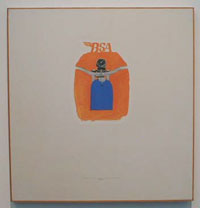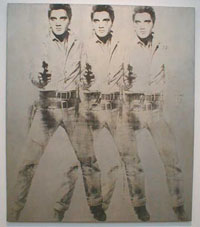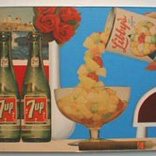Pop Art: US-UK Connections at The Menil Collection is destined to disappoint people looking for a hit parade of the usual American pop-art stars.
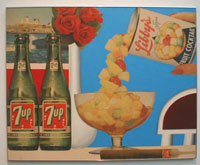
Tom Wesselmann (American, b. 1931) ...Still Life No. 16, 1962 ...Georges Pompidou Art and Culture FoundationArtwork by Tom Wesselmann/Licensed by VAGA, New York, NY
Admittedly, the show has its ups and downs; but its unevenness is its virtue: the show provides an opportunity to see some lesser-known gems, and by showing us some artists who failed we can better appreciate the achievement of those who succeeded. The show is thoughtful rather than impressive; what it does superbly is reconstruct a particular art historical moment, contrasting the different ways that the shift away from pure abstraction in the early 60’s took hold in the closely linked yet quite distinct artistic soils of Los Angeles, New York, and London.
The refreshing amateurishness of much of the work is a forceful reminder that pop began as a disreputable alternative to high art. Tom Wesselman‘s Still Life #16 slaps together photo cut outs, fabric and fields of clumsily applied flat paint with an endearing awkwardness which would get it dismissed as student work today. Billy Al Bengston‘s Gas Tank and Tachometer II is abject; its thinly painted surface in an almost empty canvas is the work of an artist pathetically struggling to invent a fresh approach to representation. Andy Warhol‘s Triple Elvis, although it has been robbed of some of its shock value by Warhol’s subsequent acceptance, is a prime example of poor craftsmanship used as a slap in the face to the hyper-refined formalism of abstract art. If this were a misprinted T-shirt, it would have been thrown away.
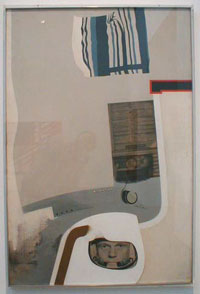
ichard Hamilton, Towards a Definitive Statement ...on the Coming Trends in Men's Wear and Accessories
Mixed in with the familiar American style comic-and-product genre of pop, the show presents a fair cross section of a distinctively British variant. In the painterly, psychological works of Derek Boshier, R. B. Kitaj, David Hockney and Allen Jones, pop is primarily a return to figuration, a new surrealism freed from the high seriousness of continental manifestoes, leaving room for the British penchant for humor. Like the prewar surrealists, these artists approach the canvas as an empty basket for the painter to fill with stuff from his head. Kitaj“s Walter Lippman is barely pop — using faces and figures vaguely taken from film noir to set up complex, ambiguous psychological narratives amid a jungle of colored stripes and planes.
The dullest bits of the show are numerous British knock-offs of American pop art. Most of the less successful British pieces ape the low art/ high art punning of American artists, even using media images drawn from American culture, a vernacular which they speak as a second language, poorly.
Richard Hamilton, difficult to classify as always, is the arch satirist of the show. Unconcerned with painting, he mixes media with abandon, poking fun at consumer culture and its transparently false ideals with a witty combination of constructivist geometry and Benny Hill. His Towards a Definitive Statement on the Coming Trends in Men’s Wear and Accessories is a topsy-turvy mélange of astronaut head, jukebox, and striped boxer shorts that derides the ridiculous fascination with the “latest thing.”
Images appear courtesy the artists and galleries.
Bill Davenport is an artist and writer and was one of the first contributors to Glasstire.


